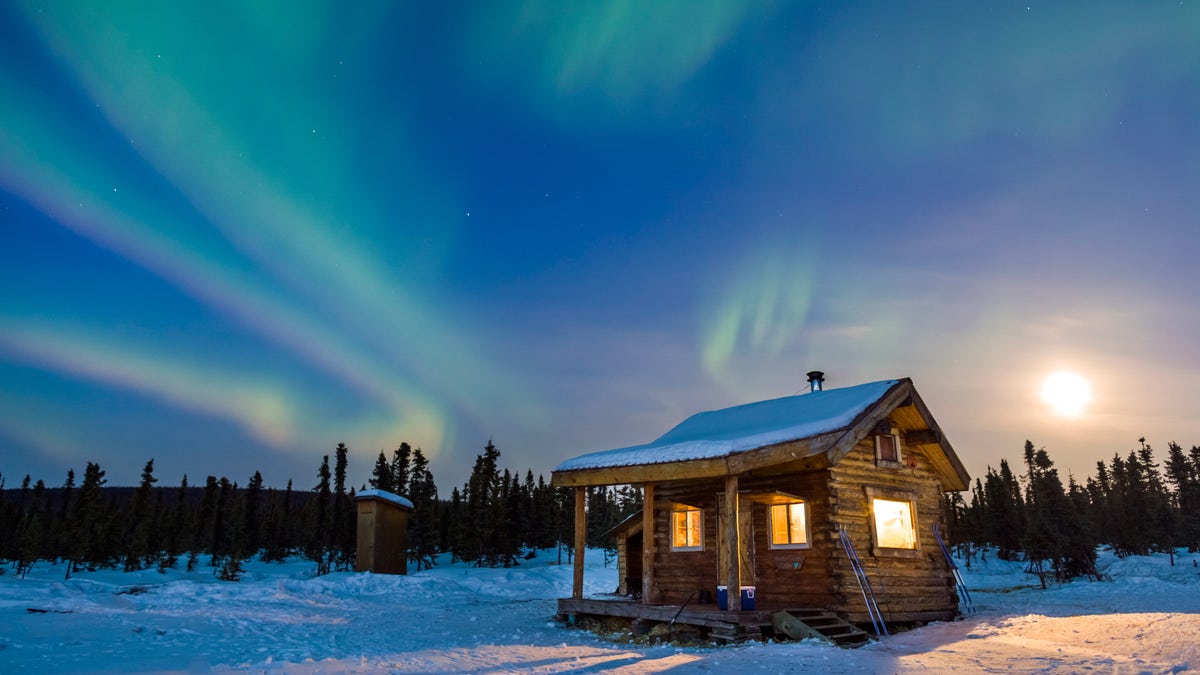
Alaska cabin, northern lights
I grew up in an 8-by-8-foot cabin with no running water, in the remote Arctic wilderness of Alaska, 200 miles north of Fairbanks. My family would be dropped off there each fall by a bush plane. All winter we would trap snowshoe hares, beavers, minks, ermine, wolverines, and foxes. In summer we would go to town to sell furs and buy buckets of rice and beans.
You might think this was a teenager's worst nightmare -- never mind not having the right clothes or car, I had an outhouse. But I so loved living in a dry cabin -- as we Alaskans call them -- that I live in one now, as do several thousand other Alaskans.
These cabins are in cities and villages, and way out in the wilderness. Their inhabitants aren't all back-to-the-land types; they are businesspeople, writers, doctors -- the same variety of folks who live in the Lower 48. Dry cabins have no indoor toilets, but they sure have charm -- and substantially lower rents. If you're looking to buy one, purchase prices are substantially lower than the median home price of almost $154,000 in Fairbanks.
My current home, where I live alone, is a one-room cabin set on cinder blocks, with a good roof, a picture window facing the sunrise, and two solar panels. It sits on a river, an hour drive and then another hour or so walk -- or in summer a 15-minute boat ride -- from Fairbanks. It cost me $26,000.
While mine is solitary, some dry cabins are in groups. They may be bare bones, or they may be large, modern, and relatively luxurious (Electricity! Floor-to-ceiling windows!).
I get water from the river in front of my house in winter, keeping a hole chopped in the ice a mile away. In the summer, when the river is too silty, I boat to a spring-fed slough or mooch from friends when I'm coming back from town. Others haul water in 5-gallon buckets or 100-gallon water tanks, filling them at commercial filling stations or at springs where locals have set up faucets.
"Not having running water is just not that big of a deal," says Kayla, a 26-year-old pre-med student who lives in a 12-by-16-foot dry cabin an hour from Anchorage. "You have a Folgers coffee can that you can pee in when you don't want to get dressed to go to the outhouse. You can have a gravity-fed water system [like a bucket on a shelf with a hose hanging down] like I have," she says. "It makes you conscientious about how much water you're using."
One of the places where you're saving water the most, of course, is the bathroom; and outhouse strategies (I'd bet you've never heard that term before) are as varied as the kinds of cabins themselves. At my friends' place -- a modern four-bedroom cabin with four balconies -- the path to their latrine is lit with Christmas lights year-round, and there is a sign informing visitors of the outhouse's proper use.
Outhouse management strategies are highly personal, sometimes strange (burn the toilet paper after using!), and often the cause of disagreements and even lifelong rifts. Outhouse character and beautification, on the other hand, are the subject of several art books. Lovely ones, really.
Of course, besides communing with nature and living conscientiously, a major advantage of dry cabin life is that it's crazy cheap. Rent is usually $400 to $600 a month -- in a state where most people would need to earn over $22 an hour to afford a two-bedroom apartment. And buying is the real bargain. Folks in the Lower 48 are always amazed that you can become a homeowner in Alaska for $20,000. Mine was extra-affordable, because it's not on the road system. Want to be closer to a major town? The prices go way up -- some cabins in Fairbanks list for as much as $99,900.
But here's the trick: You have to have cash for a dry cabin. Banks generally won't finance them -- they're concerned about the lack of utilities. And it's not that easy to find insurance coverage, either. "If someone's using a barrel stove, they're not going to get insurance," says Sally Young of Rural Alaska Real Estate. Insurance companies far prefer a modern, and much safer, appliance.
As cheap and beautiful as life is in a dry cabin, hauling water at 30 or 40 degrees below zero would not be included in most people's idea of fun. While the dry cabin lifestyle provides some built-in exercise, it also requires that you invest time and labor in simply staying alive.
When I visited a friend in his modern home for a few weeks last year, I was amazed by the comfort and ease of living in a temperature-controlled house, where a flick of the wrist could bestow not just light but also hot or cold water.
But after a few days I felt sort of fuzzy-headed from inactivity and disconnected from the physical reality of the world around me. My friend, the poor sucker, had to work 40 hours a week to pay for this comfort and a gym membership on top of it. I much prefer exercising for free in the form of chopping wood and hauling water, and a lifestyle that lets me live in, and write about, dry cabins.